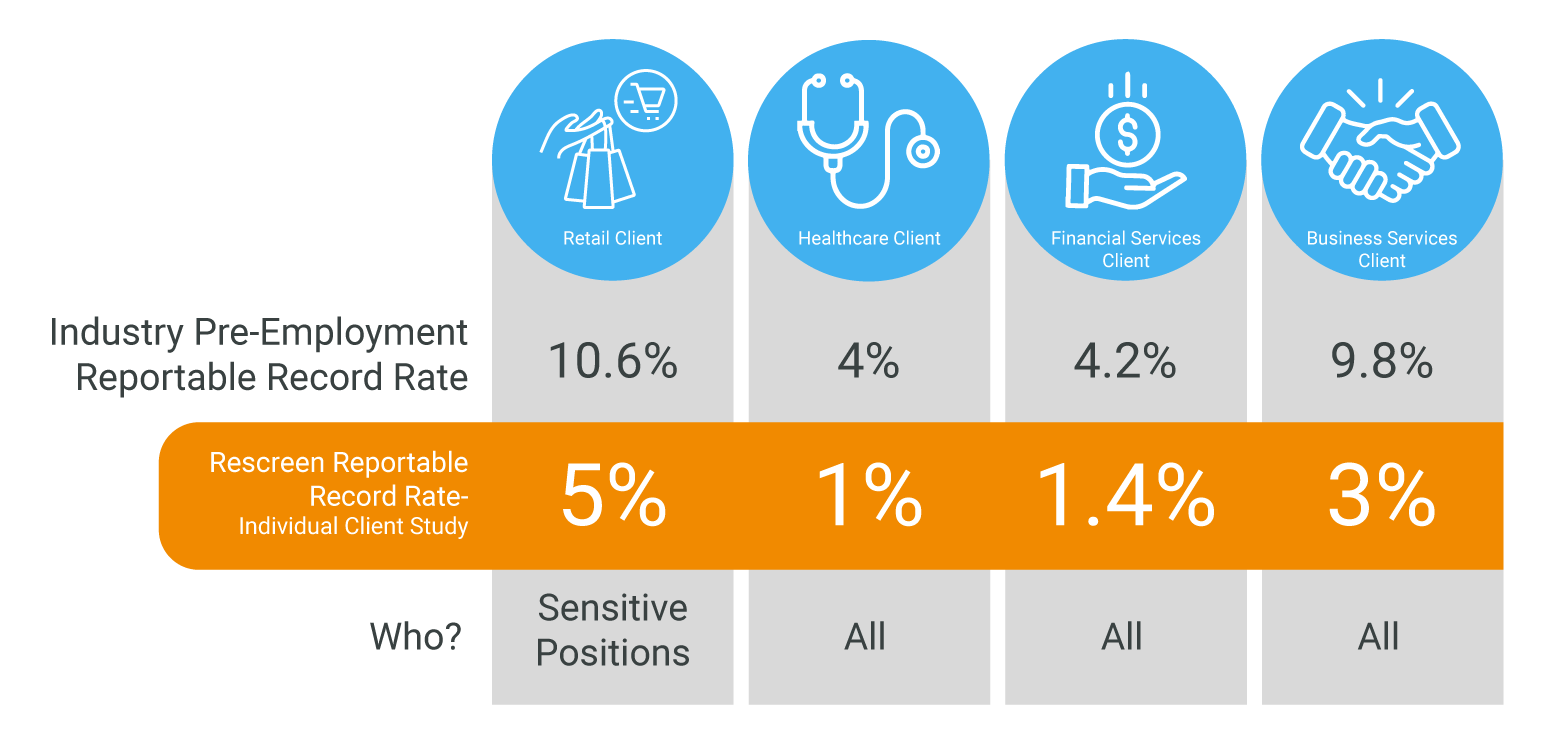Take a proactive approach to your workplace safety program. Consider periodically rescreening your employees as a part of that program to help mitigate risk.
Often in the background screening world, businesses are hyper-focused on pre-hire. The word “background” itself evokes the historical nature of assessing a candidate’s history prior to onboarding. With risk being top of mind for most customers, clients are realizing that a comprehensive screening program does not end at the candidate stage. Just because an individual’s foot is in the door, it does not mean materially significant events will not occur – crimes, driving violations, sanctions, etc. after they have been onboarded.
Through thousands of client engagements and recent client case studies, let us share what we found to be the best path to developing a rescreening program that fits the needs of your company.
What Is Rescreening?
Rescreening is the process of conducting a background check on current employees at some point post-onboarding at regular periodic intervals. From point of hire to the present, changes may have occurred in your employees’ lives that could affect their suitability for their current role. The potential risks of not knowing these changes could jeopardize your organization’s safety, security, and/or brand reputation.
Why Should I Rescreen?
Motivations differ from business to business, but here is what we’re hearing from our clients. What resonates with your business?
- Safety for customers and employees.
- Protecting brand reputation from negative or adverse headlines.
- Maintaining customer loyalty and trust
- Mitigation of risk against financial loss.
Rescreening Client Case Studies
As published in the First Advantage Annual Global Trends Report, different industries had varying pre-employment reportable record rates from criminal records background screens. This ranged from 14% of backgrounds with a criminal record (Staffing industry) to a low of 4% (Healthcare industry). We looked at clients in different industries to see how this rate changed with their post-employment rescreening programs.  Even in industries with a considerably lower pre-employment criminal record rate (healthcare and financial services), we still saw significant reportable criminal records post-hire or onboarding with rescreening. The question is-do you want to know about it first or hear about it in the news? While we can’t predict future outcomes, we can see from large client studies that there are records that businesses want to know on their employees.
Even in industries with a considerably lower pre-employment criminal record rate (healthcare and financial services), we still saw significant reportable criminal records post-hire or onboarding with rescreening. The question is-do you want to know about it first or hear about it in the news? While we can’t predict future outcomes, we can see from large client studies that there are records that businesses want to know on their employees.
Structuring Your Rescreening Program
Who Should I Rescreen?
According to our research, about half of our rescreening clients are rescreening all their employees. The others base it on employee access and responsibility. Those employees, often called keyholders, are responsible for having access to company funds, lines of code, system access, intellectual property, physical properties, and/or vulnerable populations.
What Services Should I Include in the Rescreening?
What services you’re including in your rescreening package will be dependent on your business requirements and/or regulations. The primary focus is to review areas that are non-static or subject to change from the original screening. Secondary are any additional screenings that may not have been applicable or considered initially – e.g., if the employee has since taken on a new type of role. Rescreening programs commonly include one or more of the following checks:
- Criminal and Sex Offender Registry
- Motor Vehicle Records (MVR)
- Drug Screening
- FMCSA as required by Department of Transportation (DOT)
- Licensing
- Sanctions and Media
- Credit
- Abuse Registry
When Should I Rescreen?
Clients will typically use a combination of the approaches below:
- Time-based such as annually rescreening based on an employee’s start date anniversary and/or a specific companywide date.
- Event-based such as promotions, transfers, acquisitions, security access changes, and/or conversion from temporary to permanent.
- Contractual such as when a company starts working on a new contract and/or an employee is placed on a third-party assignment.
Implementing a periodic rescreening program is a practical and effective way to identify and address potential issues.
Summary
A rescreening program is not just a good practice, it’s essential to an employer’s overall risk management program. Rescreening empowers organizations with information to help protect their most important assets-their employees and customers. First Advantage can help you develop a rescreening program that meets your risk mitigation goals.